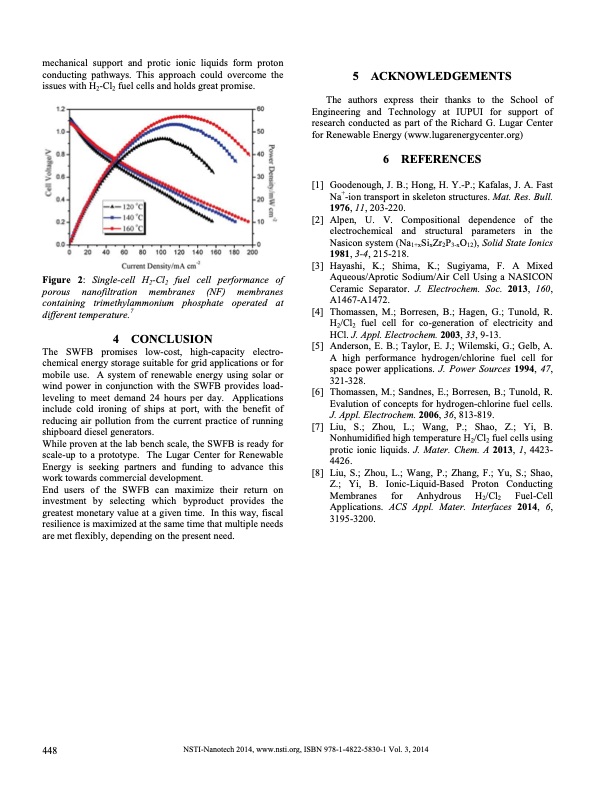
PDF Publication Title:
Text from PDF Page: 003
mechanical support and protic ionic liquids form proton conducting pathways. This approach could overcome the issues with H2-Cl2 fuel cells and holds great promise. Figure 2: Single-cell H2-Cl2 fuel cell performance of porous nanofiltration membranes (NF) membranes containing trimethylammonium phosphate operated at different temperature.7 4 CONCLUSION The SWFB promises low-cost, high-capacity electro- chemical energy storage suitable for grid applications or for mobile use. A system of renewable energy using solar or wind power in conjunction with the SWFB provides load- leveling to meet demand 24 hours per day. Applications include cold ironing of ships at port, with the benefit of reducing air pollution from the current practice of running shipboard diesel generators. While proven at the lab bench scale, the SWFB is ready for scale-up to a prototype. The Lugar Center for Renewable Energy is seeking partners and funding to advance this work towards commercial development. End users of the SWFB can maximize their return on investment by selecting which byproduct provides the greatest monetary value at a given time. In this way, fiscal resilience is maximized at the same time that multiple needs are met flexibly, depending on the present need. 5 ACKNOWLEDGEMENTS The authors express their thanks to the School of Engineering and Technology at IUPUI for support of research conducted as part of the Richard G. Lugar Center for Renewable Energy (www.lugarenergycenter.org) 6 REFERENCES [1] Goodenough, J. B.; Hong, H. Y .-P .; Kafalas, J. A. Fast Na+-ion transport in skeleton structures. Mat. Res. Bull. 1976, 11, 203-220. [2] Alpen, U. V. Compositional dependence of the electrochemical and structural parameters in the Nasicon system (Na1+xSixZr2P3-xO12), Solid State Ionics 1981, 3-4, 215-218. [3] Hayashi, K.; Shima, K.; Sugiyama, F. A Mixed Aqueous/Aprotic Sodium/Air Cell Using a NASICON Ceramic Separator. J. Electrochem. Soc. 2013, 160, A1467-A1472. [4] Thomassen, M.; Borresen, B.; Hagen, G.; Tunold, R. H2/Cl2 fuel cell for co-generation of electricity and HCl. J. Appl. Electrochem. 2003, 33, 9-13. [5] Anderson, E. B.; Taylor, E. J.; Wilemski, G.; Gelb, A. A high performance hydrogen/chlorine fuel cell for space power applications. J. Power Sources 1994, 47, 321-328. [6] Thomassen, M.; Sandnes, E.; Borresen, B.; Tunold, R. Evalution of concepts for hydrogen-chlorine fuel cells. J. Appl. Electrochem. 2006, 36, 813-819. [7] Liu, S.; Zhou, L.; Wang, P.; Shao, Z.; Yi, B. Nonhumidified high temperature H2/Cl2 fuel cells using protic ionic liquids. J. Mater. Chem. A 2013, 1, 4423- 4426. [8] Liu, S.; Zhou, L.; Wang, P.; Zhang, F.; Yu, S.; Shao, Z.; Yi, B. Ionic-Liquid-Based Proton Conducting Membranes for Anhydrous H2/Cl2 Fuel-Cell Applications. ACS Appl. Mater. Interfaces 2014, 6, 3195-3200. 448 NSTI-Nanotech 2014, www.nsti.org, ISBN 978-1-4822-5830-1 Vol. 3, 2014PDF Image | Seawater Flow Battery as Technology Platform

PDF Search Title:
Seawater Flow Battery as Technology PlatformOriginal File Name Searched:
Schubert2014Seawater.pdfDIY PDF Search: Google It | Yahoo | Bing
Product and Development Focus for Salgenx
Redox Flow Battery Technology: With the advent of the new USA tax credits for producing and selling batteries ($35/kW) we are focussing on a simple flow battery using shipping containers as the modular electrolyte storage units with tax credits up to $140,000 per system. Our main focus is on the salt battery. This battery can be used for both thermal and electrical storage applications. We call it the Cogeneration Battery or Cogen Battery. One project is converting salt (brine) based water conditioners to simultaneously produce power. In addition, there are many opportunities to extract Lithium from brine (salt lakes, groundwater, and producer water).Salt water or brine are huge sources for lithium. Most of the worlds lithium is acquired from a brine source. It's even in seawater in a low concentration. Brine is also a byproduct of huge powerplants, which can now use that as an electrolyte and a huge flow battery (which allows storage at the source).We welcome any business and equipment inquiries, as well as licensing our flow battery manufacturing.| CONTACT TEL: 608-238-6001 Email: greg@salgenx.com | RSS | AMP |